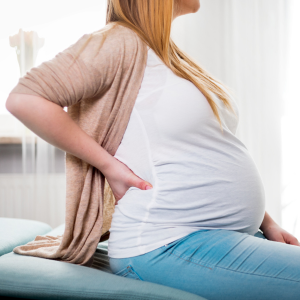Pregnancy puts extra stress on the pelvic floor, potentially having negative long-term effects. The good news is that many pelvic floor issues can be treated and prevented through bodywork, stretching, and strengthening. Pelvic floor health is vital for a healthy pregnancy! Follow along as we discuss the difference between pelvic floor dysfunction and pelvic floor disorder, as well as the symptoms, causes, treatment, and prevention of each.
What is the Pelvic Floor, and What is its Purpose?
The pelvic floor is a group of muscles, ligaments, and connective tissue that support your reproductive organs, bladder, and colon. The pelvic floor runs from the pubic bone at the front of the pelvis all the way to the tailbone and can be broken up into three parts: anterior (bladder and urethra), middle (vagina and uterus), and posterior (the anus and rectum) (1).
The pelvic floor muscles support your uterus, bladder, and bowel. They tighten and relax so that you can control when you urinate and defecate and play an important role during childbirth to help your body push out your baby (2).
Pelvic Floor Dysfunction vs. Pelvic Floor Disorders
Pelvic floor dysfunction and pelvic floor disorders are common and have similar symptoms and causes, but one deals with the pelvic floor muscles being too tight (pelvic floor dysfunction) and the other deals with the pelvic floor muscles being too weak (pelvic floor disorders).
 Pelvic floor dysfunction occurs when you have tight muscles in your pelvis that will not relax. Studies show this is a common problem, with at least one-third of adult women being affected (3). When pelvic floor muscles are too tight, it can result in lower back pain, difficulty using the bathroom, and/or pain during intercourse.
Pelvic floor dysfunction occurs when you have tight muscles in your pelvis that will not relax. Studies show this is a common problem, with at least one-third of adult women being affected (3). When pelvic floor muscles are too tight, it can result in lower back pain, difficulty using the bathroom, and/or pain during intercourse.
Symptoms may include (6):
- Painful urination
- Lower back pain
- Pain during intercourse
- Pain in your pelvic area
- Incontinence
- Constipation
- Difficulty urinating or having bowel movements
Pelvic floor disorder occurs when the muscles and/or connective tissue are weak or injured. In April of 2023, a study reported that 60% of participants suffered from at least one pelvic floor disorder during their pregnancy (4). Weak or injured pelvic floor muscles can lead to bladder control problems, bowel control problems, or pelvic organ prolapse — with 10% of women in the United States needing surgery for a pelvic floor disorder (5).
Symptoms may include (7):
- Frequent urge to urinate
- Leaking urine — especially when coughing, laughing, or exercising
- Feeling of heaviness in the vagina
- Fecal incontinence
- Constipation
- Difficulty with starting to urinate or emptying the bladder
Pelvic Organ Prolapse
Pelvic organ prolapse (POP) affects 3% of American women. It is a type of pelvic floor disorder that occurs when one or more pelvic organs drop from their normal position in the pelvis into or out of the vagina. The pelvic organs that may prolapse include the bladder, rectum, and uterus.
Symptoms of POP include (9):
- Lower back pain
- Pelvic pressure, heaviness, or pain
- Pain with intercourse
- Urinary changes – frequency, urgency, or inability to empty the bladder
- Inability to keep a tampon in
Typical treatment for pelvic organ prolapse consists of physical therapy, use of a device called a pessary (supports the prolapsed organs), and surgery. In Traditional Chinese Medicine, pelvic organ prolapse can be treated with a combination of diet, herbs, and acupuncture (10).
How are Pelvic Floor Issues Diagnosed?
Your healthcare provider will go over your symptoms and medical history in order to diagnose pelvic floor dysfunction and pelvic floor disorders. In addition to a physical exam, below are some of the tests your healthcare provider may order for you (11):
- Urodynamics – to see if you can empty your bladder
- Cystoscopy – to examine the inside of your bladder
- Dynamic defecography – to evaluate the pelvic floor and rectum during a bowel movement
- Anal manometry – to test the strength of the anal muscles
What Can Cause Pelvic Floor Dysfunction or Disorders During Pregnancy?
Many things happen to your body during pregnancy that can result in issues with your pelvic floor, resulting in pelvic floor dysfunction or disorders.
Weight Gain
During pregnancy your weight is expected to increase because of your growing baby and the necessary changes to your body. A study concluded that even healthy amounts of weight gain during pregnancy may increase the risk of pelvic floor muscle dysfunction (12).
Hormones
Relaxin is a hormone released during pregnancy that relaxes the muscles and ligaments of the pelvis resulting in increased flexibility that allows your pregnant body to stretch and make room for the growing baby. While this is important for the growth of your body and your baby, it also can put a strain on the pelvic floor by causing instability (13). Lower amounts of relaxin in early pregnancy have also been linked to pelvic floor disorders later in pregnancy (14).
What Happens to the Pelvic Floor During Childbirth?
Significant strain is put on the pelvic floor during pregnancy and increases with vaginal birth. During vaginal birth, the pelvic floor ligaments and muscles must stretch to accommodate the passage of the infant through the birth canal. Because of this additional stress, women who give birth vaginally have a higher rate of pelvic floor issues (such as urinary incontinence, an overactive bladder, and pelvic organ prolapse) than those who deliver via cesarean section (15-17).
Ways to Prevent or Treat Pelvic Floor Disorders & Dysfunction
There are various ways you can support your pelvic floor to prevent and treat pelvic floor issues. Some of these strategies include pelvic floor muscle training, prenatal yoga, perineal massage, lifestyle changes, pelvic floor physical therapy, biofeedback, and Traditional Chinese Medicine. Surgery and medication are also ways to help treat pelvic floor issues. Please discuss all of your options with your medical provider.
Pelvic Floor Muscle Training (Kegels)
Pelvic floor muscle training, also referred to as Kegel exercises, has been shown to strengthen the pelvic floor muscles and help with symptoms of urinary incontinence (18).
A study done on the role of Kegel exercises during pregnancy and after childbirth concludes that Kegels need to be performed 30 times, 1-3 times a day, for a minimum of 3 months in order to treat urinary incontinence (19). It is worth noting that Kegels need to be done correctly and consistently to see any positive effects.
For a how-to-guide by the Mayo Clinic, please refer to this article.
Prenatal Yoga
Prenatal yoga is another way to prevent pelvic floor issues.  Prenatal yoga helps to keep the tissues in your pelvic floor flexible and improve pelvic muscle strength. A study concluded that doctors may consider recommending yoga for relief of pregnancy related lower back pain as well as pelvic pain (20,21).
Prenatal yoga helps to keep the tissues in your pelvic floor flexible and improve pelvic muscle strength. A study concluded that doctors may consider recommending yoga for relief of pregnancy related lower back pain as well as pelvic pain (20,21).
Perineal Massage
A perineal massage is when you massage your perineum — the area of tissue between the opening of the vagina and the anus. The perineum is attached to the pelvic floor and massage to this area helps prepare it for stretching during a vaginal birth. A study reported that perineal massage, coupled with a warm compress, is associated with a higher frequency of intact perineum and low-severity vaginal tears as well as a lower chance of early pelvic floor dysfunction symptoms after birth (22).
Lifestyle Changes
Various lifestyle changes may help prevent issues with the pelvic floor. As a risk factor for pelvic floor dysfunction is constipation, increasing water intake and eating more fiber could prove to be beneficial (23). Fiber helps prevent constipation by assisting your body with digestion (24).
Another lifestyle change that may help prevent pelvic floor issues is physical activity. Weight training that focuses on pelvic floor muscle strength could help prevent symptoms (25).
In addition to the lifestyle changes above, learning how to relax the muscles in the pelvic floor could be beneficial. A great way to relax this part of your body is by taking a warm sitz bath.
Pelvic Floor Physical Therapy
Pelvic floor physical therapy can be helpful for those with pelvic floor disorders as well as pelvic floor dysfunction. A review looking for evidence of pelvic floor physical therapy as a treatment for pelvic floor dysfunction found that pelvic floor physical therapy can improve or remove symptoms of urinary incontinence, pelvic organ prolapse, fecal incontinence, peripartum and postpartum pelvic floor dysfunction, and more (26).
Biofeedback
The use of biofeedback usually occurs alongside pelvic floor muscle training or pelvic floor physical therapy. During your exercises you will be monitored with sensors that are put in the vagina and rectum. The biofeedback received from the sensors will reveal if you are using the correct muscles as well as the strength of the muscles you are tightening (27). A small study showed that biofeedback-assisted pelvic floor muscle training is more effective than doing pelvic floor muscle training alone (28).
Traditional Chinese Medicine
In my experience, Traditional Chinese Medicine (TCM) is one of the most effective modalities for improving symptoms of pelvic floor issues (29-32). A TCM treatment plan usually incorporates acupuncture, herbal medicine, diet & lifestyle counseling, and occasionally specialized massage. It is easily combined with any of the treatments above and may improve therapeutic outcomes. If you’re interested in trying TCM treatment, seek out a licensed provider in your area.
Summary
Pelvic floor issues can cause uncomfortable and, at times, debilitating symptoms. It is something to be especially mindful of during your pregnancy. There are various ways you can support your pelvic floor to prevent and treat pelvic floor issues. Some of these strategies include pelvic floor muscle training, prenatal yoga, perineal massage, lifestyle changes, pelvic floor physical therapy, biofeedback, and Traditional Chinese Medicine. Surgery and medication are also options to treat pelvic floor issues. Please discuss all options with your healthcare provider.
References:
- Tim, S., & Mazur-Bialy, A. I. (2021). The Most Common Functional Disorders and Factors Affecting Female Pelvic Floor. Life, 11(12), 1397. https://doi.org/10.3390/life11121397
- Pelvic Floor Muscles: Anatomy, Function & Conditions. (2022, April 13). Cleveland Clinic. https://my.clevelandclinic.org/health/body/22729-pelvic-floor-muscles
- Bump, R. C., & Norton, P. A. (1998). EPIDEMIOLOGY AND NATURAL HISTORY OF PELVIC FLOOR DYSFUNCTION. Obstetrics and Gynecology Clinics of North America, 25(4), 723–746. https://doi.org/10.1016/S0889-8545(05)70039-5
- Baruch, Y., Manodoro, S., Barba, M., Cola, A., Re, I., & Frigerio, M. (2023). Prevalence and Severity of Pelvic Floor Disorders during Pregnancy: Does the Trimester Make a Difference? Healthcare, 11(8), 1096. https://doi.org/10.3390/healthcare11081096
- Barca, J. A., Bravo, C., Pintado-Recarte, M. P., Asúnsolo, Á., Cueto-Hernández, I., Ruiz-Labarta, J., Buján, J., Ortega, M. A., & De León-Luis, J. A. (2021). Pelvic Floor Morbidity Following Vaginal Delivery versus Cesarean Delivery: Systematic Review and Meta-Analysis. Journal of Clinical Medicine, 10(8), 1652. https://doi.org/10.3390/jcm10081652
- Contributors, W. E. (n.d.). What To Know About Pelvic Floor Dysfunction. WebMD. Retrieved April 30, 2024, from https://www.webmd.com/a-to-z-guides/what-to-know-about-pelvic-floor-dysfunction#091e9c5e821c05b5-1-3
- What are the symptoms of pelvic floor disorders (PFDs)? (n.d.). Https://Www.nichd.nih.gov/. https://www.nichd.nih.gov/health/topics/pelvicfloor/conditioninfo/symptoms
- Pelvic Floor Disorders Affect Almost a Quarter of U.S. Women. (2015, May 27). National Institutes of Health (NIH). https://www.nih.gov/news-events/nih-research-matters/pelvic-floor-disorders-affect-almost-quarter-us-women
- Pelvic organ prolapse – Symptoms and causes. (2017). Mayo Clinic. https://www.mayoclinic.org/diseases-conditions/pelvic-organ-prolapse/symptoms-causes/syc-20360557
- Xu, J., & Huang, F. (2020). Original Article A study of efficacy of traditional Chinese medicine combined with biofeedback electrical stimulation on postpartum pelvic organ prolapse. Int J Clin Exp Med, 13(12), 10031–10038. https://e-century.us/files/ijcem/13/12/ijcem0120199.pdf
- How are pelvic floor disorders (PFDs) diagnosed? | NICHD – Eunice Kennedy Shriver National Institute of Child Health and Human Development. (n.d.). Www.nichd.nih.gov. https://www.nichd.nih.gov/health/topics/pelvicfloor/conditioninfo/diagnosed
- Barbosa, A. M., Marini, G., Piculo, F., Rudge, C. V., Calderon, I. M., & Rudge, M. V. (2013). Prevalence of urinary incontinence and pelvic floor muscle dysfunction in primiparae two years after cesarean section: cross-sectional study. Sao Paulo medical journal = Revista paulista de medicina, 131(2), 95–99. https://doi.org/10.1590/s1516-31802013000100019
- Cleveland Clinic. (2022, October 17). Relaxin: Hormone, Production In Pregnancy & Function. Cleveland Clinic. https://my.clevelandclinic.org/health/body/24305-relaxin
- Kristiansson, P., Samuelsson, E., Von Schoultz, B., & Svärdsudd, K. (2001). Reproductive hormones and stress urinary incontinence in pregnancy. Acta Obstetricia et Gynecologica Scandinavica, 80(12), 1125–1130. https://doi.org/10.1034/j.1600-0412.2001.801209.x
- Memon, H. U., & Handa, V. L. (2013). Vaginal Childbirth and Pelvic Floor Disorders. Women’s Health, 9(3), 265–277. https://doi.org/10.2217/whe.13.17
- Handa, V. L., Blomquist, J. L., Knoepp, L. R., Hoskey, K. A., McDermott, K. C., & Muñoz, A. (2011). Pelvic Floor Disorders 5–10 Years After Vaginal or Cesarean Childbirth. Obstetrics & Gynecology, 118(4), 777–784. https://doi.org/10.1097/aog.0b013e3182267f2f
- Blomquist, J. L., Muñoz, A., Carroll, M., & Handa, V. L. (2018). Association of Delivery Mode With Pelvic Floor Disorders After Childbirth. JAMA, 320(23), 2438. https://doi.org/10.1001/jama.2018.18315
- Media Advisory: Pelvic floor disorders linked to mode of delivery among first-time mothers | NICHD – Eunice Kennedy Shriver National Institute of Child Health and Human Development. (2018, December 18). Www.nichd.nih.gov. https://www.nichd.nih.gov/newsroom/news/121818-pelvic-floor-disorders
- Nikolovska, L., Stojanova, N., & Spasov, M. (2021). ROLE OF KEGEL EXERCISES DURING PREGNANCY AND AFTER CHILDBIRTH. KNOWLEDGE – International Journal, 48(3), 405–409. https://ikm.mk/ojs/index.php/kij/article/view/5401
- Kinser, P. A., Pauli, J., Jallo, N., Shall, M., Karst, K., Hoekstra, M., & Starkweather, A. (2017). Physical Activity and Yoga-Based Approaches for Pregnancy-Related Low Back and Pelvic Pain. Journal of Obstetric, Gynecologic & Neonatal Nursing, 46(3), 334–346. https://doi.org/10.1016/j.jogn.2016.12.006
- The Efficacy of Prenatal Yoga on Labor Pain: A Systematic Review and Meta-analysis – ProQuest. (n.d.). Www.proquest.com. https://www.proquest.com/openview/b28bc3aeb4450c88afea09fada55e03f/1?pq-origsite=gscholar&cbl=32528
- Rodrigues, S., Silva, P., Ana Catarina Borges, Sousa, N., João Neves Silva, & Escuriet, R. (2023). Effect of Perineal Massage and Warm Compresses Technique in Postpartum Pelvic Floor Dysfunction. A Secondary Analysis from a Randomised Controlled Trial. Reproductive Sciences. https://doi.org/10.1007/s43032-023-01424-4
- Pelvic floor dysfunction: prevention and non-surgical management. (2021). In PubMed. National Institute for Health and Care Excellence (NICE). https://www.ncbi.nlm.nih.gov/books/NBK579556/
- (How are pelvic floor disorders (PFDs) treated? (n.d.). Https://Www.nichd.nih.gov/. https://www.nichd.nih.gov/health/topics/pelvicfloor/conditioninfo/treatment)
- Pelvic floor dysfunction: prevention and non-surgical management. (2021). In PubMed. National Institute for Health and Care Excellence (NICE). https://www.ncbi.nlm.nih.gov/books/NBK579556/
- Wallace, S. L., Miller, L. D., & Mishra, K. (2019). Pelvic floor physical therapy in the treatment of pelvic floor dysfunction in women. Current Opinion in Obstetrics and Gynecology, 31(6), 485–493. https://doi.org/10.1097/gco.0000000000000584
- Pelvic organ prolapse – Diagnosis and treatment – Mayo Clinic. (n.d.). Www.mayoclinic.org. https://www.mayoclinic.org/diseases-conditions/pelvic-organ-prolapse/diagnosis-treatment/drc-20562951
- Ibrahim, I. K., Hameed, M. M. A., Taher, E. M., Shaheen, E. M., & Elsawy, M. S. A. G. (2015). Efficacy of biofeedback-assisted pelvic floor muscle training in females with pelvic floor dysfunction. Alexandria Journal of Medicine, 51(2), 137–142. https://doi.org/10.1016/j.ajme.2014.06.001
- Liu, H., Li, Y., Zheng, H., Miao, Y., Zhao, S., Sun, W., & Zhang, Y. (2024). Clinical efficacy of traditional Chinese medicine therapy for female stress urinary incontinence: a meta-analysis. Revista Da Escola de Enfermagem Da USP, 57, e20230153. https://doi.org/10.1590/1980-220X-REEUSP-2023-0153en
- Guo, S., Chen, Y., Tang, Q., Liu, L., & Xu, L. (2021). A Retrospective Study on Chronic Pelvic Pain Treated with Traditional Chinese Medicine Combined Therapy: 179 Cases (2016–2018). Journal of Pain Research, Volume 14, 3239–3250. https://doi.org/10.2147/jpr.s329317
- Jia, J., & Liang, J. (2023). Research Progress of Traditional Chinese Medicine in the Treatment of Pelvic Floor Spasm Constipation. International Journal of Clinical and Experimental Medicine Research, 7(2), 235–239. https://doi.org/10.26855/ijcemr.2023.04.025
- Chang, Y.-J., Chen, W.-C., Chiang, J.-H., Su, Y.-C., Tsai, K.-S., Man, K.-M., Tsai, M.-Y., Chen, Y.-H., & Chen, H.-Y. (2018). Traditional Chinese medicine decreases the obstructive uropathy risk in uterovaginal prolapse. Medicine, 97(38), e12369. https://doi.org/10.1097/md.0000000000012369







